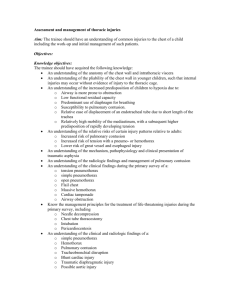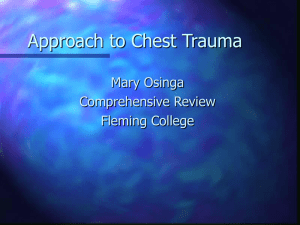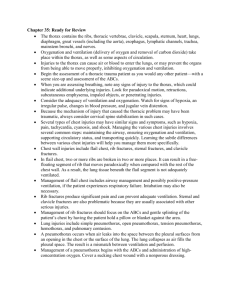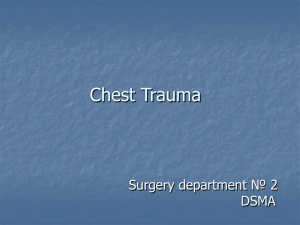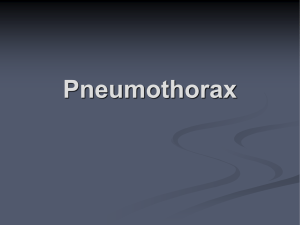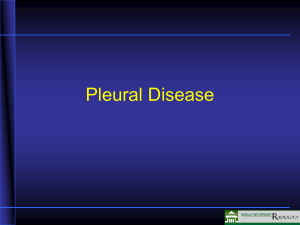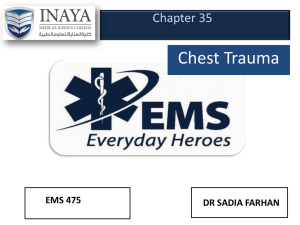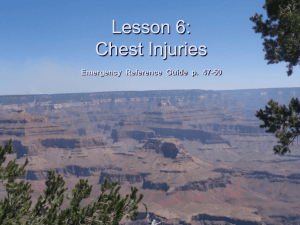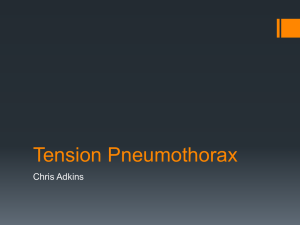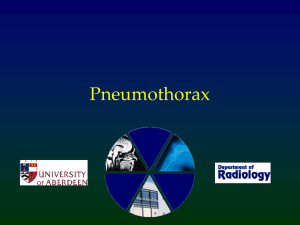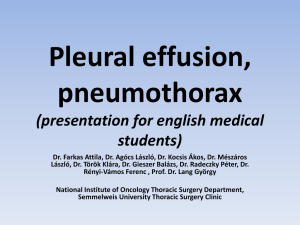thoracic injuries - Kenyatta National Hospital
advertisement
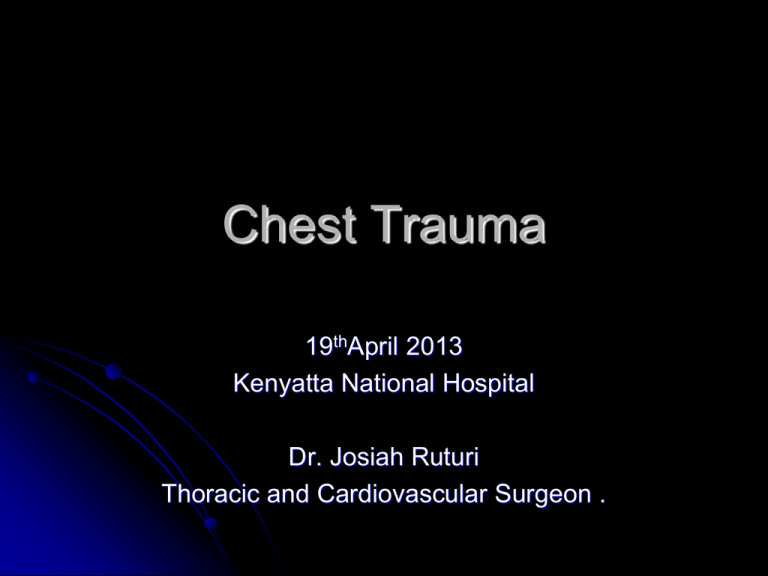
Chest Trauma 19thApril 2013 Kenyatta National Hospital Dr. Josiah Ruturi Thoracic and Cardiovascular Surgeon . - Approximately 150,000 people die each year in the United States as a result of trauma. 25% of the deaths can be directly related to thoracic injury. Almost all patients with thoracic trauma are treated conservatively with a successful outcome. urgent operative treatment was required in only: - 0.5% of blunt thoracic injuries. - 2.8% of penetrating thoracic injuries . OBJECTIIVES Identify and initiate treatment of lifethreatening thoracic injuries Primary survey Secondary survey Procedures Special considerations Immediate Life-Threatening Injuries Airway obstruction Tension Pneumothorax Open Pneumothorax Massive Hemothorax Flail Chest Cardiac Tamponade Potentially Life-Threatening Injuries: Pulmonary Contusion Myocardial Contusion Aortic Disruption Traumatic Diaphragmatic Rupture Tracheobronchial Disruption Esophageal Disruption An unstable hemodynamic state : 1. Traumatic cardiac arrest or near arrest and an Emergency department thoracotomy. 2. Cardiac tamponade 3. Persistent ATLS class III shock despite fluid resuscitation (blood loss 1500–2000 mL, pulse rate > 120, blood pressure decreased) 4. Chest Tube output > 1500 mL of blood on insertion 5. Chest Tube output > 500 mL/hour for the initial hour 6. Massive hemothorax after chest tube drainage Primary Survey Airway: patency, retractions, obstruction Breathing: exposure, rate, pattern, cyanosis Circulation: *Pulses, color, *neck veins, monitor for arrythmias *hypovolemic patients might not exhibit Initial Management Airway - with cervical spine control tracheobronchial tree disruption Breathing - tension/open pneumothorax, flail chest, lung contusion Circulation - cardiac tamponade, hemothorax, cardiac contusion, aortic disruption Specific signs and symptoms Pneumothorax Tension Pneumothorax – Hypotension, tracheal deviation, distended neck veins Pneumothorax – No signs, tachypnea, tachycardia, decreased breath sounds, hyperresonance, SQ emphysema Pneumomediastinum – Hamman’s sign, SQ emphysema Subcutaneous Emphysema Airway, Lung or Blast injury esophageal injury: Boerhaave’s Adjacent penetrating wound Progression to tension pneumothorax Pneumothorax Pneumothorax -Treatment <15% -very small spontaneous can be given 100% O2 in ED and observed <25% - simple pneumothorax can be aspirated through a small catheter Larger pneumothoraces/ underlying lung dz –tube thoracostomy Pneumonediastinum – conservative Tension Pneumothorax “one-way valve”: air enters, can’t exit displacement of mediastinum/trachea decreases venous return, displaces opposite lung Causes: spontaneous pneumothorax, blunt chest trauma, penetrating trauma Tension Pneumothorax Tension Pneumothorax A Pleural margin; partial lung collapse A: Air under tension in left thorax B: Collapsed right lung B Left Right B: pressure of tension pneumothorax pushing midline structures (heart, mediastinum) into patient’s left thoracic cavity A: air, under tension, in thoracic cavity A B Heart B Right Left Tension Pneumothorax Clinical manifestations in patient with – – – – – – – Spontaneous breathing Respiratory distress Florid face Tracheal deviation Distended neck veins Tachycardia Hypotension Needle Thoracentesis Indication: Rapidly deterioration with tension pneumothorax. Equipment – Povidone-iodine solution – 14-gauge catheter-over-needle device Technique – Cleanse overlying skin – Insert needle at 2nd or 3rd intercostal space, midclavicular line, over top of rib – Leave catheter in pleural space open to air Sucking Chest Wound AKA communicating pneumothorax Large defects: if opening > 2/3 trachea, air will pass preferentially. Cover immediately with cleanest occlusive dressing 3 sides vs 4 sides Massive Hemothorax >1500 cc blood Mechanism: – Penetrating injury of systemic or hilar vessels, especially wounds medial to nipples, scapulas. – Blunt trauma Loss of Breath sounds, dullness to percussion Flail Chest No bony continuity with rest of cage Multiple rib fractures, paradoxical movement Hypoxia from injury to underlying lung 30% missed in first 6 hours Flail chest is a marker for significant injuries Retrospective analysis, 92 pat, L-1 center. 46% had pulmonary contusion 70% had pneumo or hemothorax Great vessel, tracheobronchial injuries had no associated. 27% developed ARDS 69% required mechanical ventilation 33% mortality Ciraulo DL et al. J Am Coll Surg 1994;178(5):466. (Penn) Traumatic Aortic Injury Retrosternal/intrascapular pain Dyspnea, hoarseness, dysphagia, HTN Pseudocoarctation syndrome Hypotension Harsh systolic murmur (AI) 50% without external findings Cardiac Tamponade Penetrating injuries most common Beck’s Triad Kussmaul’s sign (rise in CVP with inspiration) Mimic: tension pneumo on left side EKG: electrical alternans (rare) Management of Tamponade: Cautious fluid management Pericardiocentesis: 15-20 cc may immediately improve hemodynamics Open thoracotomy and inspection Pericardiocentesis Indications – Immediate threat to life – Severe hemodynamic impairment – Fall in systolic blood pressure >30 mm Hg Pericardiocentesis Technique – Patient in supine position, upper torso elevated – ECG limb leads attached to patient – Use echocardiography guided procedure (rarely: ECG-guided, V lead) – Subxiphoid approach – Continuous aspiration Pulmonary Contusion Determinants of outcome ISS > 25 Initial GCS < 7 Transfusion > 3 U blood pO2/FiO2 < 300 Not correlated to shock or IV fluid administration Extent of contusion seen on initial chest X-ray not predictive of mortality or intubation. Johnson JA et al. J Trauma 1986; 26(8):695. Diaphragmatic Rupture Blunt trauma: large tears Penetrating: small tears, subtle More commonly diagnosed on the left Tracheobronchial Tree Larynx – – – – Hoarseness Subcutaneous emphysema Palpable Fracture Crepitus Trachea: – Noisy breathing – Penetrating injuries: esoph, carotid artery, jugular vein trauma Scapular and Rib Fractures Splinting impairs ventilation Majority – optimise pain mx Scapula, often indicate major injury to the head, neck, spinal cord, lungs and great vessels: mortality > 50% pain, tenderness, crepitus Sternal Fractures Mortality 25-45% Underlying injuries to myocardium Flail segment Penetrating Cardiac Injury Ventricles: will self seal more commonly RV>LV>RA>LA 56-66% overall survival 87% survival in OR thoracotomy Positive predictors: VS on admission, short transport, SW penetrating cardiac injury A combination of: - unstable patient: aggressive operative intervention - stable patient: ultrasound evaluation provided an overall survival of 40% in the patients with known cardiac injury. The diagnosis of a traumatic pericardial effusion can be made by the visualization of an echolucent region between the heart and pericardium, right ventricular diastolic collapse will confirm tamponade. ultrasound imaging appears to be with an accuracy, sensitivity, and specificity that exceeds 95% Classification of Mediastinal Injuries M1= base of the neck into mediastinum or pleura M2= one pleural cavity and mediastinal violation (central hematoma, visceral or spinal cord injury,metallic fragments in the mediastinum) M3 = parasternal injury within the nipple line or < 4 cm from the sternum M4 = two pleural cavities and mediastinal traverse. M4 - All of the mediastinal traverse injuries were caused by gunshot wounds - this trajectory had the highest rate of instability and subsequent operative intervention. - the highest observed mortality rate (60%), M1 - Injuries from a cephalad direction were predominately stab wounds. - were responsible for the second highest incidence of instability and subsequent operative intervention. The presence of a gunshot wound, was associated with significant risk of both instability and death. Penetrating Chest Trauma Low chest SW: 15% intraperitoneal, 15% require operative intervention (diaphragm) Pediatric Chest Trauma Compliance = internal injury Mobility = tension pneumos, flail chest Bronchial and diaphragmatic injuries Infrequent injuries to great vessels Summary Thoracic trauma is common in multiply injured patients Life- threatening problems may be temporarily relieved by simple measures Injury recognition important High index of suspicion for occult injuries
